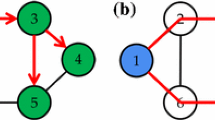Abstract
The current trend in deploying automatic control plane solutions for increased flexibility in the optical transport layer leads to numerous advantages for both the operators and the customers, but also pose challenges related to the stability of the network and its ability to operate in a robust manner under different failure scenarios. This work evaluates two rerouting strategies and proposes four policies for failure handling in a connection-oriented optical transport network, under generalized multiprotocol label switching control plane. The performance of the strategies and the policies are evaluated under multiple correlated large-scale failures. We employ the Susceptible–Infected–Disabled epidemic failure spreading model and look into possible trade-offs between resiliency and resource efficiency. Via extensive simulations, we show that source rerouting outperforms on-site rerouting, and that there exist a clear trade-off between policy performance and network resource consumption, which must be addressed by network operators for improved robustness of their transport infrastructures. Applying proactive methods for avoiding areas where epidemic failures spread results in 50 % less connections requiring recovery, which translates in improved quality of service to customers and lower recovery expenses for the network operator.

















Similar content being viewed by others
Notes
In this work, the node’s planes are considered logically separated, but physically colocated.
Since as a recovery mechanism we use restoration, the terms recovery and restoration are used interchangeably in this work.
Unlike scenario 1, where the performance is evaluated under varying severity of the epidemic failure spreading process.
References
Mannie, E. (ed.): Generalized multi-protocol label switching (GMPLS) architecture. In: RFC 3945 (2004)
Vasseur, J.-P., Pickavet, M., Demeester, P.: Network Recovery, Protection and Restoration of Optical, SONET-SDH, IP, and MPLS. Morgan-Kaufmann Publishers, Burlington (2004)
Grover, W.D.: Mesh-Based Survivable Networks—Options and Strategies for Optical, MPLS, SONET, and ATM Networking. Prentice-Hall, Upper Saddle River (2004)
Miyao, M., Saito, H.: Optimal design and evaluation of survivable WDM transport networks. IEEE J. Sel. Areas Commun. 16(7), 1190–1199 (1998)
Azim, M., et al.: Models of restoration probability in WDM networks employing active restoration. Photonic Netw. Commun. 10(2), 141–153 (2005)
Wu, Z., Savoie, M.: Gmpls control plane failure recovery. In: SPIE Proceedings, Network Architectures, Management, and Applications VI, vol. 7137 (2008)
Calle, E., Ripoll, J., Segovia, J., Vila, P., Manzano, M.: A multiple failure propagation model in GMPLS-based networks. IEEE Netw. 24(6), 17–22 (2010)
Ruepp, S., Fagertun, A.M.: Epidemic propagation of control plane failures in GMPLS controlled optical transport networks. In: IEEE DRCN (2013)
Manzano, M., Calle, E., Ripoll, J., Fagertun, A.M., Torres-Padrosa, V.: Epidemic survivability: characterizing networks under epidemic-like failure propagation scenarios. In: IEEE DRCN (2013)
Fagertun, A.M., Ruepp, S.: Connection management and recovery strategies under epidemic network failures in optical transport networks. In: Proceedings of Optical Network Design and Modelling (ONDM), Stockholm (2014)
Lang, J., Rajagopalan, B., Papadimitriou, D. (eds.): Generalized multi-protocol label switching (GMPLS) recovery functional specification. In: RFC 4426 (2006)
Satyanarayana, A., Rahman, R.: Extensions to gmpls resource reservation protocol (rsvp) graceful restart. In: RFC 5063 (2007)
Gandhi, R., Ali, Z., galimberti, G.M.: RSVP-TE extensions for signaling GMPLS restoration LSP. In: draft-gandhi-ccamp-gmpls-restoration-lsp-01 (2013)
Perelló, J., et al.: Assessment of lmp-based recovery mechanisms for gmpls control planes. In: Workshop on GMPLS Performance: Control Plane Resilience (2007)
Komolafe, O., Sventek, J.: Overview of enhancements to RSVP-TE to increase control plane resilience. In: Workshop on GMPLS Performance: Control Plane Resilience (2007)
Zhou, Z., Chen, K., Zheng, L.: Gmpls RSVP-TE signaling recovery with graceful restart in optical user network interface. In: OFC/NFOEC 2007. Conference on Optical Fiber Communication and the National Fiber Optic Engineers Conference (2007)
Manzano, M., Segovia, J., Calle, E., Vila, P., Marzo, J.L.: Modelling spreading of failures in GMPLS-based networks. In: SPECTS (2010)
Ripoll, J., Manzano, M., Calle, E.: Spread of epidemic-like failures in telecommunication networks. Phys. A 410, 457–469 (2014)
Farrel, A., et al.: Gmpls: Architecture and Applications. Morgan Kaufmann, Burlington (2006)
Komalfe, O., et al.: Overview of enhancements to RSVP-TE to increase control plane resilience. In: Workshop on GMPLS performance: Control Plane Resilience (2007)
Jajszczyk, A., Rozyki, P.: Recovery of the control plane after failures in ASON/GMPLS networks. IEEE Netw. 20, 4–10 (2006)
Berger, L.: Generalized multi-protocol label switching (GMPLS) signaling resource reservation protocol-traffic engineering (RSVP-TE) extensions. In: RFC 3473 (2003)
OPNET Modeler, Part of Riverbed. http://www.opnet.com
Inkret, R., Kuchar, A., Mikac, B. (eds.): Extd. Final Report of COST Action 266. University of Zagreb, Zagreb (2003)
USNET.24 node Reference Network. http://www.ece.virginia.edu/~optcom/Publications/OMCL-Layer-ChinaComm-13.pdf
Kosteas, V.: Epidemic network failures. In M.Sc. Thesis, DTU Fotonik (2013)
Fagertun, A.M., Ruepp, S.: Network performance improvement under epidemic failures in optical transport networks. In: OPNETWORK (2013)
Fagertun, A.M., Ruepp, S., Manzano, M.: Resolving epidemic network failures through differentiated repair times. IET Networks. ISSN: 2047-4954 (2014). doi:10.1049/iet-net.2013.0102
Author information
Authors and Affiliations
Corresponding author
Rights and permissions
About this article
Cite this article
Ruepp, S., Fagertun, A.M. & Kosteas, V. Strategies for optical transport network recovery under epidemic network failures. Photon Netw Commun 29, 330–341 (2015). https://doi.org/10.1007/s11107-015-0502-6
Received:
Accepted:
Published:
Issue Date:
DOI: https://doi.org/10.1007/s11107-015-0502-6




